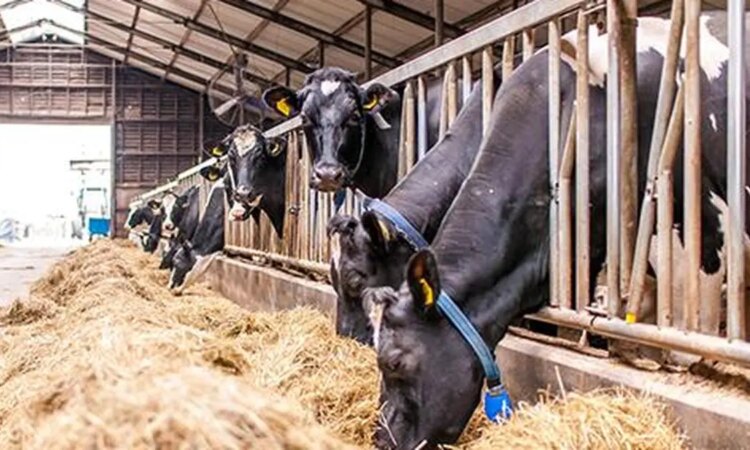
India’s livestock system is large and complex. The country’s cattle, buffalo, goat and sheep populations are among the highest globally. According to a policy paper, India faces a feed deficit of roughly 23 per cent in dry fodder, 11-32 per cent in green fodder and over 40 per cent in concentrate feed on a dry-matter basis. Moreover, average milk yield in India remains significantly below global benchmarks, partly because animals are fed low-quality crop residues and roughages. This feed-quality gap matters for both productivity (nutrition outcome) and emissions (climate outcome).
The nutrition dimension: Animal feed to human nutrition
Improved feed leads to healthier animals, higher yields of milk, eggs and meat and thereby a better supply of animal-source foods rich in protein and micronutrients (iron, zinc, vitamin B12). For example, in the Saurashtra region of Gujarat, a balanced ration programme for pastoralists saw a reduction in methane emissions alongside a small lift in milk yield and reduced feed cost per litre.
Thus, more efficient feeding supports rural incomes and the nutrition security of households (both producers and consumers). Poor feeding means lower animal outputs and higher cost per unit of output, reducing the affordability of animal-source nutrition.
The climate dimension: Feed practices and emissions
- Livestock in India contribute substantially to enteric methane and other agricultural greenhouse gases. A recent review indicates India’s cattle and buffalo herd accounts for around 14 per cent of global livestock emissions from agriculture
- Feed plays a central role: poor-quality roughage scraps take longer to ferment in the rumen, increasing methane per unit of product. For example, conversion of straw and crop residues has much lower digestibility than good green fodder or well-balanced rations
- Interventions that improve nutrition, feed digestibility, ration balance, and add anti-methanogenic additives can reduce methane per litre of milk or kilogramme of meat. One Indian example: the supplement Harit Dhara developed by ICAR National Institute of Animal Nutrition and Physiology (NIANP) showed ~17-20 % methane reduction alongside higher milk/weight gain in trials
- More recently, a seaweed‑based feed supplement is being explored in India that could reduce methane by up to 90 per cent under ideal circumstances
Key priorities and strategic actions
To ensure that feed and fodder become central to India’s climate-nutrition roadmap, the following priorities stand out:
● Expand fodder production and conservation: Promote fodder crop cultivation (sorghum, berseem, maize silage) and scale up silage and hay conservation so green fodder availability is less seasonal.
● Improve digestibility and nutrient value of feeds: Interventions such as urea-molasses treatment of straw, chopping green fodder, increasing concentrate supplementation and mineral mixtures help raise feed efficiency and reduce emissions.
● Tailor feed strategies for smallholders: More than 70 per cent of livestock are owned by small and marginal farmers and technologies and subsidies must reach them so that feed upgrades are inclusive.
● Link feed interventions to mitigation incentives: Since better feed reduces emissions intensity, climate-policy instruments such as carbon credits, methane-reduction programmes could reward farmers and feed-processors for improved practices.
● Strengthen value-chains, infrastructure and finance: Building fodder-seed farms, feed-processing units, silage-storage, transportation and enabling entrepreneur development under schemes like NLM will be critical.
● Monitor and integrate into nutrition policies: Government nutrition programmes (for children, pregnant women) increasingly emphasise animal-source foods; ensuring stable and improved livestock productivity via better feed supports those goals.
Policy framework and institutional measures
Government schemes already include feed/fodder development. For example, the National Livestock Mission (NLM) promotes green fodder, silage making, chaff cutting, improved feed and rationing. Policy papers highlight that without bridging the feed/fodder gap (which is large, particularly for green and dry fodder), the livestock sector’s productivity potential remains constrained.
To align with climate objectives, it is essential to explicitly incorporate feed interventions into India’s nationally determined contributions (NDCs), livestock greenhouse gas inventories and planning for dairy and animal husbandry. While partnerships with the private sector present new opportunities, challenges such as cost, supply chains and farmer adoption remain critical obstacles to overcome.
Conclusion
Feed plays an indispensable role in India’s dual task: improving nutrition outcomes via increased supply of animal-source foods, and reducing the climate intensity of livestock production. When smart feed interventions, ranging from silage and residue up-grading to balanced rations, and novel additives are scaled, they can raise productivity, lower emissions per unit of output and bolster rural incomes and nutrition. Realising this potential will demand concerted efforts across policy, private-sector innovation and farmer-level implementation.
(The author is Chairman, CLFMA of India)
Published on November 2, 2025




